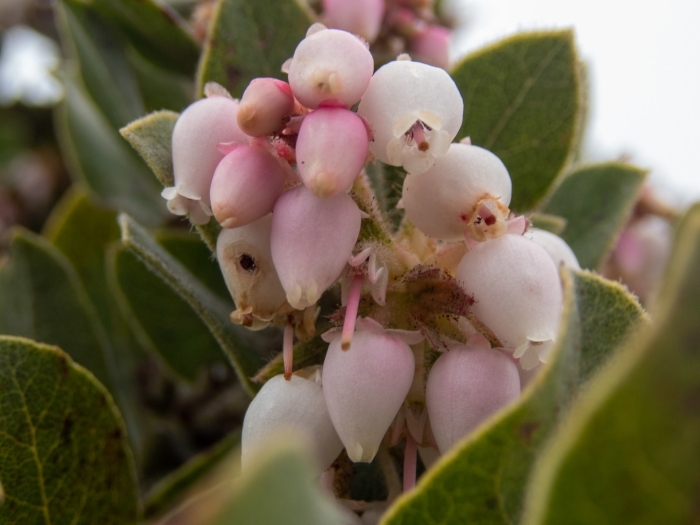Montara Manzanita
(Arctostaphylos montaraensis)
Montara Manzanita (Arctostaphylos montaraensis)
/
/

Will Sides
CC BY 4.0
Image By:
Will Sides
Recorded By:
Copyright:
CC BY 4.0
Copyright Notice:
Photo by: Will Sides | License Type: CC BY 4.0 | License URL: http://creativecommons.org/licenses/by/4.0/ | Rights Holder: Will Sides | Publisher: iNaturalist | Date Created: 2021-03-13T12:39:31-08:00 |

















































Estimated Native Range
Summary
Arctostaphylos montaraensis, commonly known as Montara Manzanita, is an evergreen shrub native to the coastal chaparral and sandy soils of the Montara Mountain area in San Mateo County, California. This species is adapted to a Mediterranean climate with wet winters and dry summers. It typically forms a mounding to erect habit, with heights ranging from 0.5 meters (1.6 ft) on exposed granite outcrops to 5 meters (16 ft) in more sheltered conditions. The multiple trunks and stems are notable for their deep reddish-brown bark, which peels in thin sheets. The inflorescence is a dense cluster of urn-shaped flowers, each white in color, just under a centimeter long, with bristles inside, and they are quite showy when in bloom. The flowering period extends from January through March. Following the flowers, the plant produces small red fruits resembling tiny apples, which are a characteristic feature of the genus.
Montara Manzanita is valued for its attractive bark, evergreen foliage, and winter flowering period, which provides a splash of color when few other plants are in bloom. It is commonly used in California native plant gardens, drought-tolerant landscapes, and for natural habitat restoration projects. The plant thrives in full sun, requiring very low to low amounts of water once established, and prefers well-drained soils, often found in its native sandy habitats. While it is generally low-maintenance, it can be susceptible to fungal diseases such as root rot if drainage is poor. Montara Manzanita is not known for aggressive roots or significant disease problems, but it can be sensitive to overwatering and excessive fertilization. It is also important to note that this species, like many California natives, has evolved with fire and can resprout following wildfires.CC BY-SA 4.0
Montara Manzanita is valued for its attractive bark, evergreen foliage, and winter flowering period, which provides a splash of color when few other plants are in bloom. It is commonly used in California native plant gardens, drought-tolerant landscapes, and for natural habitat restoration projects. The plant thrives in full sun, requiring very low to low amounts of water once established, and prefers well-drained soils, often found in its native sandy habitats. While it is generally low-maintenance, it can be susceptible to fungal diseases such as root rot if drainage is poor. Montara Manzanita is not known for aggressive roots or significant disease problems, but it can be sensitive to overwatering and excessive fertilization. It is also important to note that this species, like many California natives, has evolved with fire and can resprout following wildfires.CC BY-SA 4.0
Plant Description
- Plant Type: Shrub
- Height: 12-15 feet
- Width: 10-12 feet
- Growth Rate: Moderate
- Flower Color: White
- Flowering Season: Spring, Winter
- Leaf Retention: Evergreen
Growth Requirements
- Sun: Full Sun
- Water: Very Low, Low
- Drainage: Fast
Common Uses
Bee Garden, Bird Garden, Butterfly Garden, Deer Resistant, Drought Tolerant, Hummingbird Garden, Low Maintenance, Showy Flowers
Natural Habitat
Native to coastal chaparral and sandy soils of the Montara Mountain area in San Mateo County, California
Other Names
Common Names:
Scientific Names: , Arctostaphylos montaraensis, Arctostaphylos imbricata subsp. montaraensis,
GBIF Accepted Name: Arctostaphylos montaraensis Roof